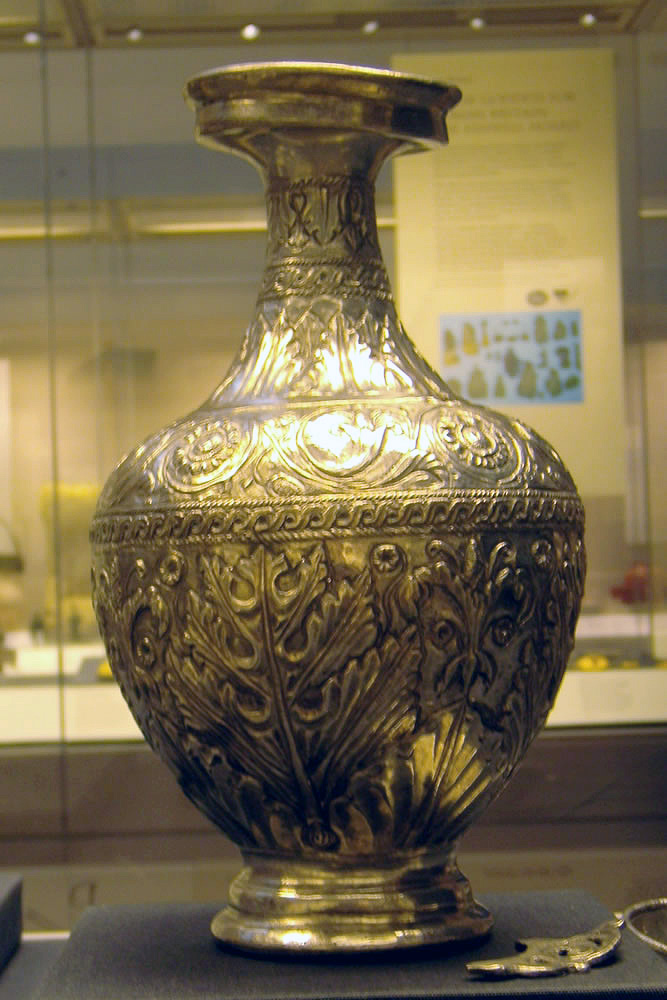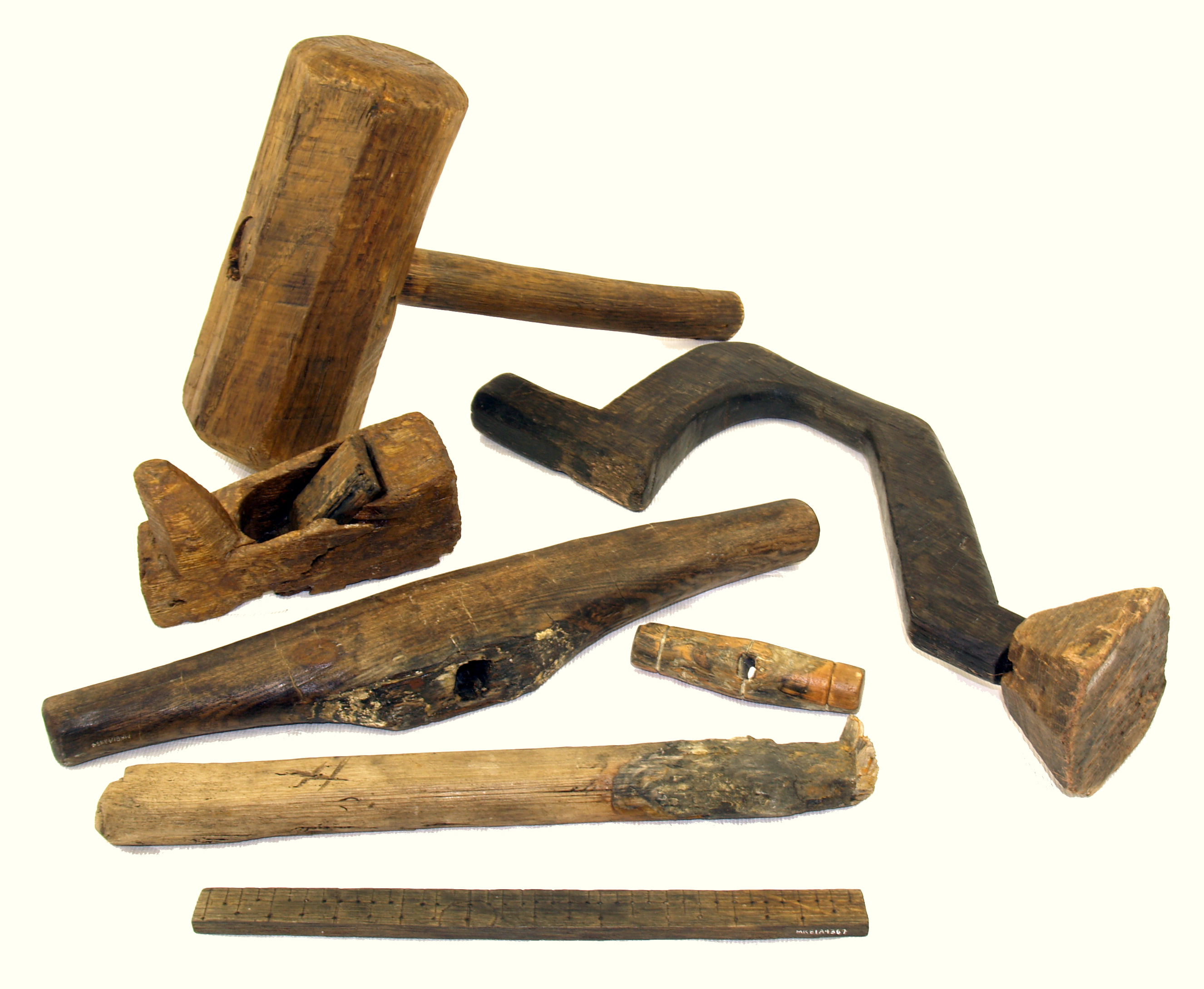|
Hoards
A hoard or "wealth deposit" is an archaeological term for a collection of valuable objects or artifacts, sometimes purposely buried in the ground, in which case it is sometimes also known as a cache. This would usually be with the intention of later recovery by the hoarder; hoarders sometimes died or were unable to return for other reasons (forgetfulness or physical displacement from its location) before retrieving the hoard, and these surviving hoards might then be uncovered much later by metal detector hobbyists, members of the public, and archaeologists. Hoards provide a useful method of providing dates for artifacts through association as they can usually be assumed to be contemporary (or at least assembled during a decade or two), and therefore used in creating chronologies. Hoards can also be considered an indicator of the relative degree of unrest in ancient societies. Thus conditions in 5th and 6th century Britain spurred the burial of hoards, of which the most famous ... [...More Info...] [...Related Items...] OR: [Wikipedia] [Google] [Baidu] |
Hoxne Hoard
The Hoxne Hoard ( ) is the largest hoard of late Roman silver and gold discovered in Britain, and the largest collection of gold and silver coins of the fourth and fifth centuries found anywhere within the former Roman Empire. It was found by Eric Lawes, a metal detectorist in the village of Hoxne in Suffolk, England in 1992. The hoard consists of 14,865 Roman gold, silver, and bronze coins and approximately 200 items of silver tableware and gold jewellery. The objects are now in the British Museum in London, where the most important pieces and a selection of the rest are on permanent display. In 1993, the Treasure Valuation Committee valued the hoard at £1.75 million (about £ in ). The hoard was buried in an oak box or small chest filled with items in precious metal, sorted mostly by type, with some in smaller wooden boxes and others in bags or wrapped in fabric. Remnants of the chest and fittings, such as hinges and locks, were recovered in the excavation. The coins of ... [...More Info...] [...Related Items...] OR: [Wikipedia] [Google] [Baidu] |
Mildenhall Treasure
The Mildenhall Treasure is a large hoard of 34 masterpieces of Roman silver tableware from the fourth century AD, and by far the most valuable Roman objects artistically and by weight of bullion in Britain. It was found at West Row, near Mildenhall, Suffolk, in 1942. It consists of over thirty items and includes the Great Dish which weighs over . The collection is on view in the British Museum because of its immense importance and value, and replicas are on show in the local museum at Mildenhall. History of discovery The hoard was discovered while ploughing in January 1942 by Gordon Butcher, who removed it from the ground with help from Sydney Ford, for whom he was working at the time. Many details of the discovery remained uncertain, not least because it took place in wartime. Apparently they did not at first recognise the objects for what they were, though Ford collected ancient objects. Ford cleaned the pieces and displayed them in his house, using some of them as daily ... [...More Info...] [...Related Items...] OR: [Wikipedia] [Google] [Baidu] |
Fishpool Hoard
In 1966 the Fishpool Hoard of 1,237 15th century gold coins, four rings and four other pieces of jewellery, and two lengths of gold chainThe Fishpool hoard . British Museum was discovered by workmen on a building site near present-day Cambourne Gardens, in , , England, an area that was then known as "Fishpool". It is the largest of medieval coins ever found in Britain. To judge from the [...More Info...] [...Related Items...] OR: [Wikipedia] [Google] [Baidu] |
Coin
A coin is a small, flat (usually depending on the country or value), round piece of metal or plastic used primarily as a medium of exchange or legal tender. They are standardized in weight, and produced in large quantities at a mint in order to facilitate trade. They are most often issued by a government. Coins often have images, numerals, or text on them. ''Obverse'' and its opposite, ''reverse'', refer to the two flat faces of coins and medals. In this usage, ''obverse'' means the front face of the object and ''reverse'' means the back face. The obverse of a coin is commonly called ''heads'', because it often depicts the head of a prominent person, and the reverse ''tails''. Coins are usually made of metal or an alloy, or sometimes of man-made materials. They are usually disc shaped. Coins, made of valuable metal, are stored in large quantities as bullion coins. Other coins are used as money in everyday transactions, circulating alongside banknotes. Usually the hi ... [...More Info...] [...Related Items...] OR: [Wikipedia] [Google] [Baidu] |
Cuerdale Hoard
The Cuerdale Hoard is a hoard of more than 8,600 items, including silver coins, English and Carolingian jewellery, hacksilver and ingots. It was discovered on 15 May 1840 on the southern bank of a bend of the River Ribble, in an area called Cuerdale near Preston, Lancashire, England. The Cuerdale Hoard is one of the largest Viking silver hoards ever found, four times larger than its nearest rival in Britain or Ireland, according to Richard Hall. In weight and number of pieces, it is second only to the Spillings Hoard found on Gotland, Sweden. The coins in the hoard are from three sources, represented in the proportions 5:1:1. Viking kingdoms of eastern England are represented in the largest portion; the other two portions are of Alfred's Kingdom of Wessex and of coins from foreign sources, which include Byzantine, Scandinavian, Islamic, Papal, North Italian and Carolingian mintings, many of the last from Aquitaine perhaps, Richard Hall suggests, acquired there in the Viking ... [...More Info...] [...Related Items...] OR: [Wikipedia] [Google] [Baidu] |
Water Newton Treasure
The Water Newton Treasure is a hoard of fourth-century Roman silver, discovered near the location of the Roman town of '' Durobrivae'' at Water Newton in the English county of Cambridgeshire in 1975. The hoard consisted of 27 silver items and one small gold plaque. Because of inscriptions found on some of the pieces in the collection it has been suggested that they may have been used in a local church, and they therefore comprise the earliest probable group of Christian liturgical silver yet found in the Roman Empire. The hoard was discovered during ploughing in February 1975; several items were damaged by the plough. It was probably buried by an inhabitant of the nearby Roman fortified garrison town of ''Durobrivae''. There are nine silver vessels, and the remainder of the items are votive tokens engraved and embossed with the labarum (the chi-rho cross), mostly of triangular shape. The larger items include jugs, bowls, dishes, a strainer, and an unengraved standing two- ... [...More Info...] [...Related Items...] OR: [Wikipedia] [Google] [Baidu] |
Tool
A tool is an object that can extend an individual's ability to modify features of the surrounding environment or help them accomplish a particular task. Although many animals use simple tools, only human beings, whose use of stone tools dates back hundreds of millennia, have been observed using tools to make other tools. Early human tools, made of such materials as stone, bone, and wood, were used for preparation of food, hunting, manufacture of weapons, and working of materials to produce clothing and useful artifacts. The development of metalworking made additional types of tools possible. Harnessing energy sources, such as animal power, wind, or steam, allowed increasingly complex tools to produce an even larger range of items, with the Industrial Revolution marking an inflection point in the use of tools. The introduction of widespread automation in the 19th and 20th centuries allowed tools to operate with minimal human supervision, further increasing the productivity ... [...More Info...] [...Related Items...] OR: [Wikipedia] [Google] [Baidu] |
Pottery
Pottery is the process and the products of forming vessels and other objects with clay and other ceramic materials, which are fired at high temperatures to give them a hard and durable form. Major types include earthenware, stoneware and porcelain. The place where such wares are made by a ''potter'' is also called a ''pottery'' (plural "potteries"). The definition of ''pottery'', used by the ASTM International, is "all fired ceramic wares that contain clay when formed, except technical, structural, and refractory products". In art history and archaeology, especially of ancient and prehistoric periods, "pottery" often means vessels only, and sculpted figurines of the same material are called " terracottas". Pottery is one of the oldest human inventions, originating before the Neolithic period, with ceramic objects like the Gravettian culture Venus of Dolní Věstonice figurine discovered in the Czech Republic dating back to 29,000–25,000 BC, and pottery vessels tha ... [...More Info...] [...Related Items...] OR: [Wikipedia] [Google] [Baidu] |
Glass
Glass is a non-Crystallinity, crystalline, often transparency and translucency, transparent, amorphous solid that has widespread practical, technological, and decorative use in, for example, window panes, tableware, and optics. Glass is most often formed by rapid cooling (quenching) of the Melting, molten form; some glasses such as volcanic glass are naturally occurring. The most familiar, and historically the oldest, types of manufactured glass are "silicate glasses" based on the chemical compound silicon dioxide, silica (silicon dioxide, or quartz), the primary constituent of sand. Soda–lime glass, containing around 70% silica, accounts for around 90% of manufactured glass. The term ''glass'', in popular usage, is often used to refer only to this type of material, although silica-free glasses often have desirable properties for applications in modern communications technology. Some objects, such as drinking glasses and glasses, eyeglasses, are so commonly made of silicate- ... [...More Info...] [...Related Items...] OR: [Wikipedia] [Google] [Baidu] |
Silver Coin Hoard
Silver is a chemical element with the symbol Ag (from the Latin ', derived from the Proto-Indo-European ''h₂erǵ'': "shiny" or "white") and atomic number 47. A soft, white, lustrous transition metal, it exhibits the highest electrical conductivity, thermal conductivity, and reflectivity of any metal. The metal is found in the Earth's crust in the pure, free elemental form ("native silver"), as an alloy with gold and other metals, and in minerals such as argentite and chlorargyrite. Most silver is produced as a byproduct of copper, gold, lead, and zinc refining. Silver has long been valued as a precious metal. Silver metal is used in many bullion coins, sometimes alongside gold: while it is more abundant than gold, it is much less abundant as a native metal. Its purity is typically measured on a per-mille basis; a 94%-pure alloy is described as "0.940 fine". As one of the seven metals of antiquity, silver has had an enduring role in most human cultures. Other than in cu ... [...More Info...] [...Related Items...] OR: [Wikipedia] [Google] [Baidu] |
Tesoro De Villena 04
Tesoro or El Tesoro may refer to: People *Ashley Tesoro (born 1983), American actress, model, and singer **Tesoro Ministry Foundation, a charity *Donya Tesoro (born 1991), a Filipina politician *Giuliana Tesoro (1921–2002), Italian-born American chemist * Kermit Tesoro (born 1988), a Filipino designer * Laura Tesoro (born 1996), Belgian singer and actress *Michelle Tesoro, American film editor Places * Tesoro railway station, in Bari, Italy *Camp El Tesoro, a camp in Granbury, Texas, U.S. * El Tesoro, Maldonado, Uruguay *Monte Tesoro, a summit of the Bergamasque Prealps in Italy * Tesoro, a station on Line 1 of the Guadalajara light rail system Other uses *Tesoro Corporation, later known as Andeavor, an American oil and gas company *Dipartimento del Tesoro, or simply "Tesoro", the Italian department of treasury *Tesoro High School, in Las Flores, California, U.S. *''Tesoro'', a 13th-century translation of ''Li Livres dou tresor'' by Brunetto Latini *''El tesoro'', a 2016 Colo ... [...More Info...] [...Related Items...] OR: [Wikipedia] [Google] [Baidu] |
Categorization
Categorization is the ability and activity of recognizing shared features or similarities between the elements of the experience of the world (such as objects, events, or ideas), organizing and classifying experience by associating them to a more abstract group (that is, a category, class, or type), on the basis of their traits, features, similarities or other criteria that are universal to the group. Categorization is considered one of the most fundamental cognitive abilities, and as such it is studied particularly by psychology and cognitive linguistics. Categorization is sometimes considered synonymous with classification (cf., Classification synonyms). Categorization and classification allow humans to organize things, objects, and ideas that exist around them and simplify their understanding of the world. Categorization is something that humans and other organisms ''do'': "doing the right thing with the right ''kind'' of thing." The activity of categorizing things can be ... [...More Info...] [...Related Items...] OR: [Wikipedia] [Google] [Baidu] |







